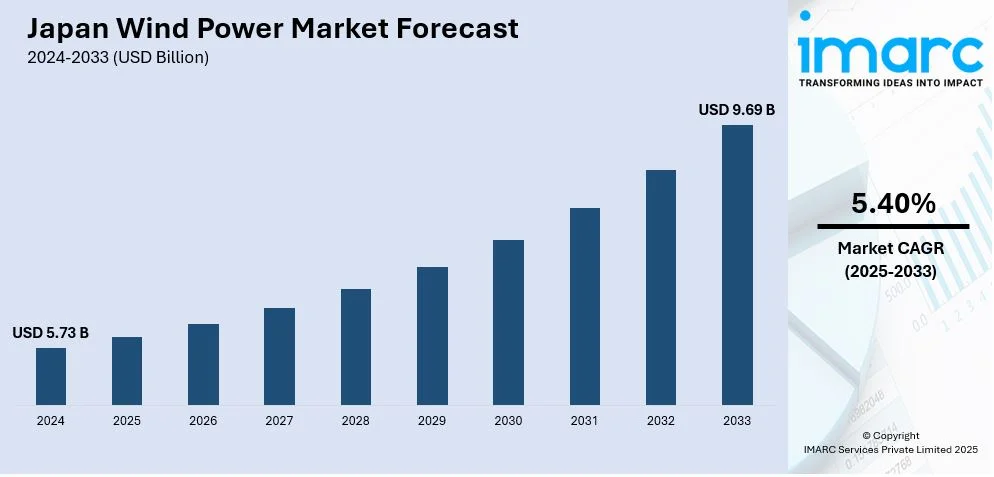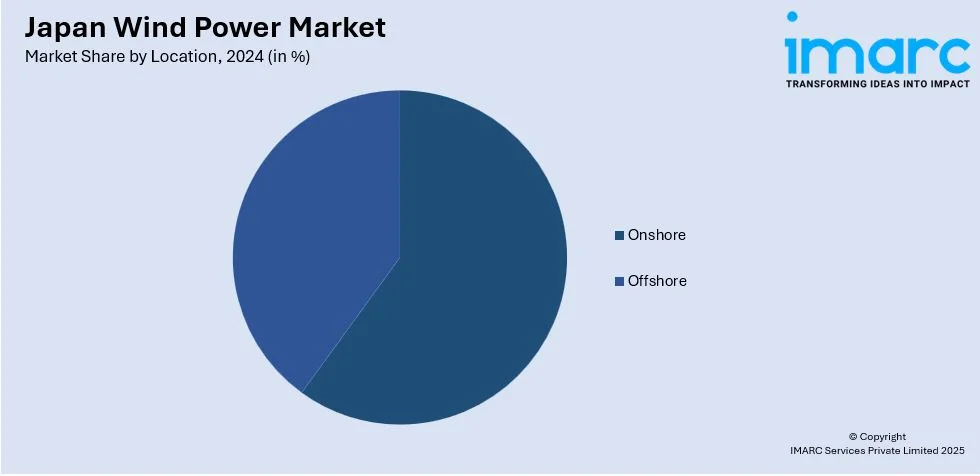
Japan Wind Power Market Size, Share, Trends and Forecast by Location and Region, 2025-2033
Japan Wind Power Market Overview:
The Japan wind power market size reached USD 5.73 Billion in 2024. Looking forward, IMARC Group expects the market to reach USD 9.69 Billion by 2033, exhibiting a growth rate (CAGR) of 5.40% during 2025-2033. Favorable government initiatives, technological advancements, and growing demand for renewable energy are supporting the market growth. Moreover, Japan's commitment to carbon neutrality by 2050, rising energy demand, environmental sustainability awareness, and aging power infrastructure are fueling the market growth. Furthermore, reduced wind turbine costs, advancements in floating wind turbine technology, international partnerships, enhanced grid integration, growing consumer support, and global market collaborations are factors boosting Japan wind power market share.
|
Report Attribute
|
Key Statistics
|
|---|---|
|
Base Year
|
2024
|
|
Forecast Years
|
2025-2033
|
|
Historical Years
|
2019-2024
|
| Market Size in 2024 | USD 5.73 Billion |
| Market Forecast in 2033 | USD 9.69 Billion |
| Market Growth Rate 2025-2033 | 5.40% |
Japan Wind Power Market Trends:
Government Initiatives and Policy Support
The Japanese government is actively working to ensure the growth of the wind power sector through various initiatives. Key government policies, such as the introduction of feed-in tariffs (FITs) and auctions, have provided financial incentives to wind energy investors. In addition, Japan's Ministry of the Environment is working to streamline the wind farm project permitting process, reducing bureaucratic queues, and accelerating the project lead time. In 2024, Japan's Cabinet approved a draft bill amending the Marine Renewable Energy Act, which permits the installation of wind turbines off the coast of Japan's Exclusive Economic Zones (EEZs). This move is meant to facilitate giant projects and increase the nation's ambition of becoming carbon neutral by 2050, with 10 GW of offshore wind capacity by 2030 and up to 45 GW by 2040. These policies provide long-term price stability, which is vital in making the nation appealing to local and foreign investments, further fostering market growth.

Technological Advancements in Wind Turbine Design
Technological advancements that have fueled growth in wind turbine technology have played a crucial role in increasing the cost-effectiveness and viability of the product in Japan. In line with this, advancements in turbine capacity, blade technology, and efficiency have allowed wind power generation to compete with traditional sources of power, further propelling market growth. Technology improvements, such as better material quality and bigger rotor diameters, have significantly contributed to producing energy from wind turbines even during substandard winds. In addition to this, design innovation of offshore windmills with floating turbine technology has opened the way to accommodate wind farms at deeper oceanic waters, which is stimulating the Japan wind power market growth. These technologies play an instrumental role in the utilization of the country's wind resources, especially offshore, where it has immense potential that is still untapped.
Geographic and Offshore Wind Resource Potential
Geographically, there is abundant wind power potential for Japan, especially along its coastlines and offshore locations. Its long coastline and good wind regime provide the perfect locations for onshore and offshore wind farms. The government has identified offshore wind as a high-priority choice, with megaprojects planned along Hokkaido, Honshu, and Kyushu coastlines. On the other hand, offshore wind farms are located in relatively deep water, and it is well-suited for floating wind turbine technology. This implies that turbines can be installed away from the coast, where they will be less visible and fewer in conflict with other sea-based uses. Furthermore, floating offshore wind farms are seen as a key growth driver for Japan's wind power industry. The nation's aspiration to utilize such resources is demonstrated by investment and the creation of a smooth infrastructure to facilitate the operation of offshore wind farms, which is also fueling market growth.
Japan Wind Power Market Segmentation:
IMARC Group provides an analysis of the key trends in each segment of the market, along with forecasts at the country and regional levels for 2025-2033. Our report has categorized the market based on location.
Location Insights:

- Onshore
- Offshore
The report has provided a detailed breakup and analysis of the market based on the location. This includes onshore and offshore.
Regional Insights:
- Kanto Region
- Kansai/Kinki Region
- Central/Chubu Region
- Kyushu-Okinawa Region
- Tohoku Region
- Chugoku Region
- Hokkaido Region
- Shikoku Region
The report has also provided a comprehensive analysis of all the major regional markets, which include Kanto Region, Kansai/Kinki Region, Central/Chubu Region, Kyushu-Okinawa Region, Tohoku Region, Chugoku Region, Hokkaido Region, and Shikoku Region.
Competitive Landscape:
The market research report has also provided a comprehensive analysis of the competitive landscape. Competitive analysis such as market structure, key player positioning, top winning strategies, competitive dashboard, and company evaluation quadrant has been covered in the report. Also, detailed profiles of all major companies have been provided.
Japan Wind Power Market News:
- In 2024, Tokyo Gas acquired a 21% stake in Portugal's WindFloat Atlantic, the world's first semi-submersible floating wind farm. This investment marks Tokyo Gas's first direct entry into an overseas floating offshore wind farm and is expected to provide insights beneficial for advancing Japan’s own floating offshore wind initiatives.
- In 2024, BP and Japan's JERA established a 50-50 joint venture, JERA Nex BP, to develop offshore wind farms. BP will invest up to USD 3.25 billion, while JERA will contribute USD 2.55 billion, aiming for a total capacity of 13 GW.
Japan Wind Power Market Report Coverage:
| Report Features | Details |
|---|---|
| Base Year of the Analysis | 2024 |
| Historical Period | 2019-2024 |
| Forecast Period | 2025-2033 |
| Units | Billion USD |
| Scope of the Report |
Exploration of Historical Trends and Market Outlook, Industry Catalysts and Challenges, Segment-Wise Historical and Future Market Assessment:
|
| Locations Covered | Onshore, Offshore |
| Regions Covered | Kanto Region, Kansai/Kinki Region, Central/Chubu Region, Kyushu-Okinawa Region, Tohoku Region, Chugoku Region, Hokkaido Region, Shikoku Region |
| Customization Scope | 10% Free Customization |
| Post-Sale Analyst Support | 10-12 Weeks |
| Delivery Format | PDF and Excel through Email (We can also provide the editable version of the report in PPT/Word format on special request) |
Key Questions Answered in This Report:
- How has the Japan wind power market performed so far and how will it perform in the coming years?
- What is the breakup of the Japan wind power market on the basis of location?
- What is the breakup of the Japan wind power market on the basis of region?
- What are the various stages in the value chain of the Japan wind power market?
- What are the key driving factors and challenges in the Japan wind power?
- What is the structure of the Japan wind power market and who are the key players?
- What is the degree of competition in the Japan wind power market?
Key Benefits for Stakeholders:
- IMARC’s industry report offers a comprehensive quantitative analysis of various market segments, historical and current market trends, market forecasts, and dynamics of the Japan wind power market from 2019-2033.
- The research report provides the latest information on the market drivers, challenges, and opportunities in the Japan wind power market.
- Porter's five forces analysis assist stakeholders in assessing the impact of new entrants, competitive rivalry, supplier power, buyer power, and the threat of substitution. It helps stakeholders to analyze the level of competition within the Japan wind power industry and its attractiveness.
- Competitive landscape allows stakeholders to understand their competitive environment and provides an insight into the current positions of key players in the market.
Need more help?
- Speak to our experienced analysts for insights on the current market scenarios.
- Include additional segments and countries to customize the report as per your requirement.
- Gain an unparalleled competitive advantage in your domain by understanding how to utilize the report and positively impacting your operations and revenue.
- For further assistance, please connect with our analysts.
 Request Customization
Request Customization
 Speak to an Analyst
Speak to an Analyst
 Request Brochure
Request Brochure
 Inquire Before Buying
Inquire Before Buying




.webp)




.webp)












